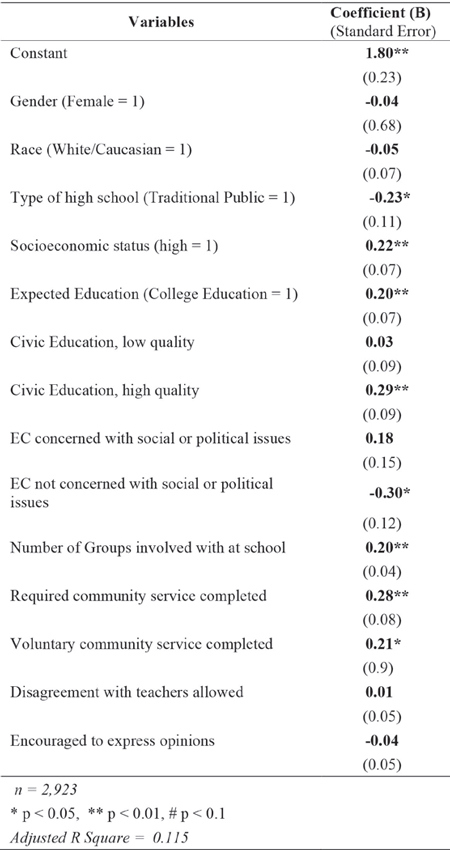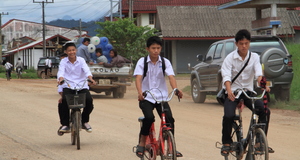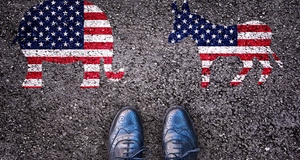From Clocks and Clouds VOL. 6 NO. 2Revitalizing Young-Adult Citizenship: An Analysis of High-School Predictors on Civic EngagementClassroom ClimateThe next multiple regression analysis involved classroom climate variables. The first variable measured participants' responses to the statement "in general, students could disagree with teachers, if respectful." The second classroom climate indicator statement measured was "in general, students were encouraged to express their opinions." For both, responses were measured on a five-point scale from "1" coded as "strongly disagree" to "5" coded as "strongly agree." As seen in Table 3, the predictor related to disagreement with teacher produced significant results, but the variable relating to the expression of opinion was not significant. Although the disagreement with teachers variable did yield a positive significant result at the p < 0.05 level, the coefficient size of 0.06 is relatively small compared to every demographic variable coefficient except for race. Furthermore, the "encouraged to express opinions" did not have a significant coefficient, and the relationship was even negative. Table 3: Level of Civic Engagement following the 2012 Presidential Election among 18-24 year-old US Citizens with Classroom Climate Predictors When looking at the coefficient sizes, the effect of classroom climate on civic engagement is small compared to other variables in this equation. Given the insignificance of the second variable, it is difficult to reject the null hypothesis of no relationship when only one of the two classroom climate variables served as a significant predictor of civic engagement. These findings do not suggest the strength of relationship found in Campbell (2008). In this regression analysis, the same three demographic variables that were significant in the previous two analyses remained significant. Socioeconomic status and expected education were positively and significantly related to respondents' civic engagement outcome. Like previous regressions indicated, public high school attendance also was a significant variable, but the correlation was negative. Community ServiceOf the participants in this survey, 2,923 were asked if they worked on a service project in high school. 49.7 percent (n=1454) indicated that they had worked on a such a project, while 50.3 percent (n=1469) stated they did not participate in a service project for school. Of the students who did complete a service project, they were asked whether they served as part of a voluntary act (n=671) or as a requirement (n=783). As shown in Table 4 below, participation in both voluntary and required service projects led to significant results. For the initial multiple regression analysis with community service project predictors, as shown in Table 4, the participation in community service was a significant predictor, both for required community service and voluntary community service at the p < 0.01 level. For students who performed voluntary community service, their average civic engagement score was 2.31, and the average civic engagement score for students completing required community service was 2.19. These were both higher than the average score of 1.73 for those students performing no service. Since both required and voluntary service had significant results, this suggests that participating in service, regardless of one's motives behind the involvement, contributes to higher civic engagement scores. Table 4: Level of Civic Engagement following the 2012 Presidential Election among 18-24 year-old US Citizens with Community Service Predictors What would be helpful to further investigate this relationship would be to know what types of service the students performed. The data does not differentiate between those who committed to ongoing service projects versus one-time events, and the length of commitment (or lack thereof) to service activities could make a difference. But, by having the required service category with significant results, we are able to see results for those who do not self-select into the activity. Similar to the previous regressions, too, socioeconomic status and expected education were both significant, with a positive correlation. Public high school attendance was significant too, but the coefficient was negative, again suggesting that students who attended private, religious, and non-traditional schools may have exhibited stronger civic engagement levels. Comprehensive Multiple RegressionFor the final multiple regression analysis performed, all of the independent variables and demographic factors were included in the same equation. The results are below in Table 5. Discussion of Comprehensive Multiple Regression AnalysisIn this multiple regression analysis, both some independent variables and some of the demographic variables yielded significant outcomes as predictors. High quality civic education, community service involvement, and some extracurricular activities served as positive predictors for higher levels of civic engagement. Table 5: Level of Civic Engagement following the 2012 Presidential Election among 18-24 year-old US Citizens with all included Predictors For the two classroom climate variables, neither of the two predictors yielded significant results in this analysis. Even though the variable "disagreement with teachers allowed" was significant at the p < 0.05 level in the regression that included only classroom climate and demographic variables, this significant relationships disappeared when in a model that included all of the variables. With the weak effects of classroom climate demonstrated here, other more tangible aspects of the educational experience such as community service, extracurricular involvement and a high quality civics class were of greater impact as predictors in the comprehensive multiple regression analysis. For civic education predictors, high quality civic education produced a significant coefficient value, but low quality education was not significant in this analysis. As noted in the earlier discussion of civic education variables, it is not necessarily important that a student took a class related to civics or American government for high civic education levels. What was important was that the course provided high quality instruction. In fact, relative to all of the other variables in this analysis, and excluding the control coefficient, the high quality civic education predictor produced the largest coefficient of 0.29. However the data in this study does not control for whether students self-selected into the civics courses due to a prior interest in politics or whether they were required to take a course. If the students chose to take the civics course out of a personal interest, it is likely that they would enjoy the content of the course and also have high levels of civic engagement after attending high school. In other words, despite the large coefficient relative to the others, this relationship may not indicate a causal link, but rather indicates that students who rank civics courses as "high quality" may be predisposed to having high civic engagement. As for extracurricular activity involvement, the number of extracurricular groups a respondent was involved in during high school yielded significant results at the p < 0.01 level. There was a positive correlation between the number of groups a student was involved in and the student's civic engagement score, with a coefficient of 0.20. Relative to the high quality civic education mentioned above, this is a slightly smaller coefficient. Also, relative to both required and voluntary community service predictors, the effect the number of extracurricular activities was smaller. Whether any of these extracurricular groups were related to social or political issues mattered, too. Similar to the multiple regression that focused solely on extracurricular activities, there was a negative, significant correlation between non-political extracurricular activities and civic engagement. But this time, relative to the impact of all the other categories of predictors, involvement in activities related to social or political issues was not significant. As mentioned above, for the community service predictors, positive and significant coefficients were the results for both the voluntary and mandatory dummy variables. With both types of service being significant predictors, the act of community service, regardless of the motivation behind the service, appears to be the driving force behind the significance in these variables. Interestingly, the coefficient was slightly larger for required service (0.28) over voluntary service (0.21). These community service results support Hart et al.'s findings (2007) that service can promote civic engagement, even when mandatory. In fact, besides the coefficient of the constant, required community service was the second largest positive coefficient at 0.28, only behind high quality civic education, which had a significant coefficient of 0.29. As such, this weakens and disagrees with Snyder & Clary's hypothesis that mandatory service projects fosters resentment, and in turn, counteracts civic engagement (1999). Additionally, because the mandatory community service variables help to control for the self-selection issue that presented itself with the civic education and extracurricular variables, there exists a stronger argument for a causal relationship between community service and future civic engagement. Even for students who did not self-select into community service, community service served as a significant predictor of civic engagement compared to those who engaged in no community service whatsoever. With this considered, these results support the hypothesis that community service would be one of the strongest predicting variables in the comprehensive multiple regression analysis. Finally, the constant, and a few of the demographic variables, also yielded significant results in this analysis. Type of high school, socioeconomic status, and expected education were all significant at the p < 0.05 level. Similar to previous analyses, the correlation between public high school attendance and civic engagement was negative. However, high socioeconomic status and an expected college education were both positively correlated with the mean civic engagement of 1824 year-olds. ConclusionFrom the analysis in this study, several important observations can be made for educators and policymakers alike. First, the importance of community service as a predictor of civic engagement is evident in the final regression analysis. Regardless of whether the service was performed voluntarily or as a requirement, both variables were significant. Incorporating service into the high school experience may serve as a way to foster civic engagement in students. For civic education, only high quality education was significant amongst the civic education variables. With this information, educators may consider focusing on civic education best practices to ensure the education is providing students with adequate knowledge and tools about American government and means to participate in civic life. Limitations to this study include the inability to account for selection bias with the civic education classes and extracurricular activities. It is unknown whether these students opted into take a course about civic education, or whether it was required by school policies. Additionally, the data did not provide for whether students optionally engaged in extracurricular activities, whether at least some activities were required, or whether students had the choice to self-select or opt-in to political and nonpolitical activities. Furthermore, the respondents self-reported the information about their experiences, and the survey included no mechanism to verify the responses. Respondents may have over-reported involvement in high school functions, and with this being a retrospective analysis for many of the participants, it may have been difficult to recall all of this information. With that, it is difficult to be certain of the accuracy of this data to the true experiences of US citizens ages 18-24. In the future, it would be of interest to further investigate the role of community service with civic engagement. With both required and voluntary community service yielding being significant predictors in the final regression analysis, there is reason to consider investigating commitments to community service. For example, I would recommend studying whether there is difference in outcome between sustained, long-term service versus shortterm community service activities. Time investment in community service activities may enrich students' interests, knowledge, and engagement levels with social and community issues, which may, in turn, help develop stronger tendencies to be civically engaged. Additionally, another avenue for research could be an investigation of why students who reported attending traditional public schools were associated with a negative, significant coefficient in the regression equation. It would be worthwhile to study the qualities and practices of private and nontraditional schools in order to research why the discrepancy exists between school type and civic engagement levels. AuthorKari Lorentson was a student of Political Science. She graduated in December of 2015. School of Public Affairs (SPA), American University. ReferencesAnnette, John. 2005. "Character, Civic Renewal and Service Learning for Democratic Citizenship in Higher Education." British Journal of Educational Studies 53, no.3 (Sept. 2005) 326-340. Burns, N., Scholzman, K.L, and Verba, S. (2001). The Private Roots of Public Action: Gender, Equality, and Political Participation. Cambridge, MA: Harvard University Press. Campbell, David, Meira Levinson, and Frederick Hess. 2012. Making Civics Count: Citizenship Education for a New Generation. Cambridge: Harvard Education Press. Campbell, David. 2007. "Sticking Together: Classroom Diversity and Civic Education." American Politics Research 35 no. 1 (January 2007): 57-78. Campbell, David. 2008. "Voice in the Classroom: How an Open Classroom Climate Fosters Political Engagement Among Adolescents." Political Behavior, no. 30 (2008): 437-454. Crystal, D.S. and DeBell, M. 2002. "Sources of Civic Orientation among Youth: Trust, Religion, Valuation, and Attributions of Responsibility. Political Psychology 23 (2002): 113-132. Ehman, Lee H. 1969. "An Analysis of the Relationship of Selected Educational Variables with the Political Socialization of High School Students." American Educational Research Journal 6, no. 4 (November 1969): 559-580. File, Thom. 2013. "Young-Adult Voting: An Analysis of Presidential Elections, 1964-2012." Current Population Survey Reports, P20-572. U.S. Census Bureau, Washington, DC. Glanville, Jennifer. "Political socialization or selection? Adolescent extracurricular participation and political activity in early adulthood." Social Science Quarterly 80 (1999): 279-290. Hart, Daniel, Thomas M. Donnelly, James Youniss, and Robert Atkins. 2007. "High School Community Service as a Predictor of Adult Voting and Volunteering." American Educational Research Journal, 44, no. 1(March 2007): 197-219. Kahne, Joseph E. and Susan E. Sporte. 2008. "Developing Citizens: The Impact of Civic Learning Opportunities on Students' Commitment to Civic Participation." American Educational Research Journal, 45, no. 3 (Sept. 2008): 738-766. Langton, Kenneth P. and M. Kent Jennings. 1968. "Political Socialization and the High School Civics Curriculum in the United States. "The American Political Science Review 62, no. 3 (Sep., 1968): 852-867. Levine, Peter. The Commission on Youth Voting and Civic Knowledge Post-Election Survey 2012. ICPSR 35012-version. Ann Arbor, MI: Inter-university Consortium for Political and Social Research, 4 June 2014. Web. 7 November 2015. Manning, Nathan and Kathy Edwards. 2014. "Does Civic Education for Young People Increase Political Participation? A Systematic Review." Educational Review 66, no. 1 (2014): 22-45. M., Snyder and E. Clary. 1999. "The Effect of ‘Mandatory Volunteerism' on Intentions to Volunteer. Psychological Science, 10 (1999): 59-64. Niemi, Richard G, Mary A Hepburn, and Chris Chapman. 2000. "Community Service by High School Students: A Cure for Civic Ills?" Political Behavior 22, no. 1 (2000): 45-64. Putnam, R. D. (2000). Bowling Alone: The collapse and revival of American community. New York: Simon and Schuster. Rimukete, Laura, Riikka Hirvone, Asko Tolvanen, Kaisa Aunola, and Jari-Erik Nurmi. 2012. "Parents' Roles in Adolescents'' Educational Expectations." Scandinavian Journal of Educational Research 56, no.6 (2012): 571-590. Stukas, A., M. Snyder, and E. Clary. 1999. The Effect of "Mandatory Volunteerism" on Intensions to Volunteer." Psychological Science 10 (1999): 59-64. Tourney, Purta, J., Barber, C.H., & Wilkenfeld, B. (2007). "Latino Adolescents' Civic Engagement in the United States: Research Results from the IEA Civic Education Study." Journal of Youth and Adolescence, 36(111-125). U.S. Department of Education, Office of the Under Secretary and Office of Postsecondary Education "Advancing Civic Learning and Engagement in Democracy: A Road Map and Call to Action," Washington, D.C., 2012. U.S. Department of Education. "A Crucible Moment: College Learning and Democracy's Future," Washington, D.C., 2011. Verba, S. Schlozman, K.L., & Brady, H. (1995). Voice and equality: Civic Voluntarism in American Politics. Cambridge, MA: Harvard University Press. Woolf, Patrick. 2007. "Civics Exam: Schools of Choice Boost Civic Values." Education Next, 7, no. 3: (66-72). Youniss, James. "How to Enrich Civic Education and Sustain Democracy." 2012. Making Civics Count: Citizenship Education for a New Generation. Cambridge: Harvard Education Press. Suggested Reading from Inquiries Journal
Inquiries Journal provides undergraduate and graduate students around the world a platform for the wide dissemination of academic work over a range of core disciplines. Representing the work of students from hundreds of institutions around the globe, Inquiries Journal's large database of academic articles is completely free. Learn more | Blog | Submit Latest in Political Science |






















